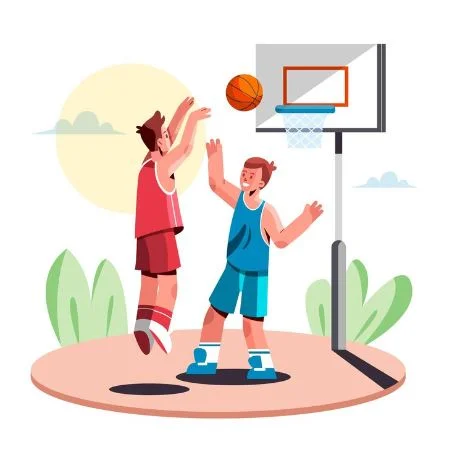The Complete Guide to Drawing Basketball: Tips, Techniques, and Tools
Drawing basketball scenes and players can be a fun and rewarding experience. Whether you’re just starting out or have some experience, understanding the basics and using the right techniques will help you create better drawings. This guide covers everything you need to know about drawing basketballs and players.
1. Getting Started with Basketball Drawing
Understanding Basketball Anatomy
To draw a basketball accurately, you need to know what it looks like:
- Basketball Basics: A basketball is a round, orange ball with black lines. Practice drawing it from different angles to capture its 3D shape correctly.
- Player Anatomy: Basketball players are often in dynamic poses with strong muscles. Study their movements during activities like dribbling and shooting to draw them accurately.
2. Essential Drawing Techniques
Basic Drawing Techniques
Here’s how to start drawing a basketball:
- Simple Circle Method: Begin by drawing a perfect circle for the basketball. Use a compass or trace a round object to get it right.
- Adding Details: Draw the characteristic lines on the basketball—one vertical, one horizontal, and two curved lines to create the ball’s pattern.
- Shading and Texturing: To make your basketball look real, use shading to show its roundness. Smooth gradients will help create depth.
Advanced Techniques
To make your drawings more lifelike:
- Perspective: Draw from different angles to add realism. Practice drawing the basketball from various perspectives to improve your skills.
- Dynamic Poses: Capture the movement of basketball players by using gesture drawing. This helps in showing action and energy in their poses.
3. Tools and Materials for Basketball Drawing
Basic Tools
Start with these essentials:
- Pencils: Use pencils of different hardness (HB, 2B, 4B) for shading and outlining. Softer pencils are good for dark areas, while harder ones work for lighter lines.
- Erasers: A kneaded eraser is great for lifting graphite and creating highlights on the basketball.
- Paper: Choose smooth, high-quality drawing paper for clean lines and accurate shading.
Advanced Tools
For more detailed work:
- Blending Stumps: Useful for smooth shading and blending.
- Colored Pencils: Add color to bring your drawing to life.
- Digital Tools: Software like Adobe Photoshop or Procreate can enhance your drawing with features like layers and blending tools.
4. Common Mistakes and How to Avoid Them
Avoiding Mistakes
To improve your drawings:
- Incorrect Proportions: Check the size and placement of the basketball and players. Use guidelines to ensure everything is proportionate.
- Overlooking Details: Pay attention to small details like the texture of the basketball and the player’s uniform.
- Neglecting Practice: Drawing gets better with practice. Set aside time to draw and try different techniques.
5. Improving Your Basketball Drawing Skills
Practice and Learning
To get better:
- Study Professional Artwork: Look at drawings by professional artists to learn their techniques and styles. This can inspire your own work.
- Take Drawing Classes: Consider enrolling in drawing classes or workshops for feedback and new skills.
- Join Drawing Communities: Share your work and get constructive criticism from others. Online forums and social media groups are great places for support.
6. Advanced Drawing Concepts
Perspective and Depth
Add depth to your drawings:
- Using Perspective: Incorporate perspective to make your drawings more realistic. Practice drawing from different angles and using vanishing points.
- Capturing Motion: Draw multiple images of the basketball in different positions to show movement and action.
Drawing Basketball Players
To draw players realistically:
- Proportions and Anatomy: Focus on the player’s proportions and anatomy. Use reference images for accuracy.
- Dynamic Movement: Use gesture drawing techniques to capture the energy and movement of players.
7. Showcasing Your Work
Creating a Portfolio
Gather your best drawings into a portfolio, whether physical or digital.
Sharing on Social Media
Share your art on platforms like Instagram and Pinterest. Use relevant hashtags and engage with the community to gain visibility.
8. FAQs
What is the best pencil for drawing basketballs?
A range of pencils from HB to 4B works well. Harder pencils are good for light lines, and softer pencils are better for shading.
How can I improve my shading techniques?
Practice different shading methods like cross-hatching and blending. Use a blending stump for smooth transitions.
Are there online courses for drawing basketballs?
Yes, platforms like Udemy and Skillshare offer courses on drawing sports and other subjects.
Can I draw basketballs on a tablet?
Absolutely. Digital drawing tablets offer many tools and features that can enhance your drawing process.
How do I add realism to my basketball drawings?
Focus on accurate proportions, realistic shading, and texture. Using reference images can also help improve realism.
Conclusion
Drawing basketball scenes and players involves understanding basic techniques, using the right tools, and practicing regularly. By improving your skills and avoiding common mistakes, you can create detailed and dynamic basketball drawings. Keep practicing, studying professional work, and exploring advanced techniques to enhance your artistry.






